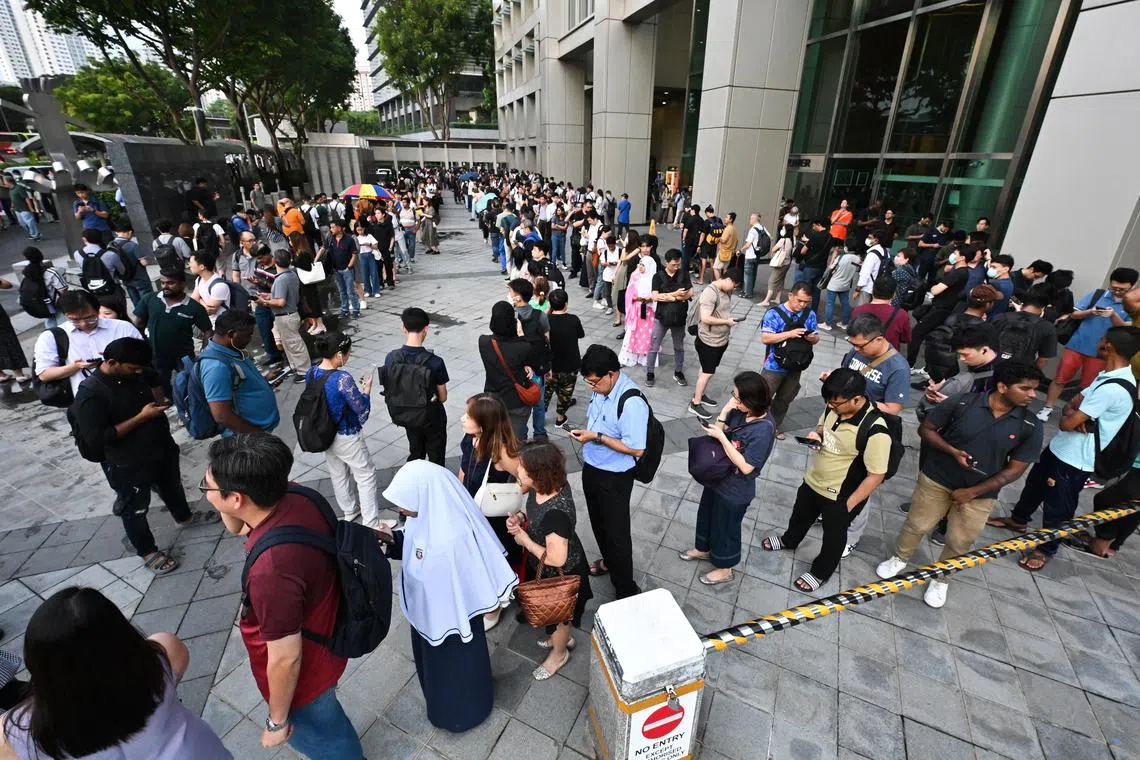Repair and alternative transport costs during 6-day MRT line disruption factored into SMRT’s $3m fine
Sign up now: Get ST's newsletters delivered to your inbox
Follow topic:
SINGAPORE – In the wake of one of the worst MRT disruptions in Singapore’s history, SMRT spent more than $10 million on alternative travel arrangements and repairs. These costs were taken into consideration when the Land Transport Authority (LTA) meted out a $3 million fine to the rail operator.
The six-day disruption on the East-West MRT line
Announcing the completion of investigations into the disruption, the LTA said on June 3 that the financial penalty was proportionate to the circumstances surrounding the incident.
The fine collected will go to the Public Transport Fund, which helps lower-income families defray public transport expenditures.
In its report on the investigation findings
It also recognised how SMRT was quick to limit the affected sector of the East-West Line – between Jurong East and Buona Vista stations – once it was safe to do so.
Shuttle train services between Boon Lay and Jurong East stations, and between Queenstown and Buona Vista stations, allowed bridging shuttle bus services to be further optimised and to help cut the additional journey time for affected travellers, it said.
Apart from SMRT’s own efforts, LTA contractors from other ongoing rail projects were called in to help with the repair and restoration work.
Asked for a breakdown of costs incurred, SMRT said for repairs, the main cost came from replacing the damaged rails and putting in trackside equipment. The total cost included paying for LTA’s contractors, it added.
Repairs were completed on Sept 30, and normal train services resumed on Oct 1 after safety runs were conducted.
The $3 million fine is the second-highest penalty to be levied on a rail operator, after the record $5.4 million fine that SMRT incurred for a disruption in July 2015 that crippled the entire North-South and East-West lines for more than two hours during the evening peak period.
Asked why a lower fine was imposed for the September 2024 incident, an LTA spokesperson said that while the disruption lasted for six days, a shorter stretch of four stations was affected.
Given the extent of the damage, five of the six days were spent on repair and recovery works before train service could be resumed safely, the spokesperson added.
“We had assessed that SMRT had recovered the system in the shortest time possible without compromising safety, and therefore did not penalise SMRT for unnecessarily prolonging the disruption.”

LTA’s spokesperson also noted that before the incident, the East-West Line had a mean kilometres between failure (MKBF) of more than 2 million train-km. This means that trains on the line travelled for more than two million km between delays of more than five minutes.
In the July 2015 disruption, electrical power trips at multiple locations had crippled two of the MRT network’s most heavily utilised lines, affecting about 413,000 commuters.
A tunnel leak and lack of maintenance were found to have caused the breakdown.
The MKBF for the entire rail network in 2015 was 133,000km.
SMRT was previously fined $2 million for two major disruptions on the North-South Line in 2011 that triggered a Committee of Inquiry.
Both incidents were caused by sagging power-supplying rails, and affected 221,000 passengers combined.

Passengers queueing for bus bridging service outside Ministry of Education building near Buona Vista MRT station at 6.39pm on Sept 25, 2024.
ST PHOTO: LIM YAOHUI
To find out what led to the September 2024 disruption, the LTA engaged an expert advisory panel. It also commissioned a specialist testing and certification company to conduct an independent forensic analysis into how the axle box, which allows the wheels to rotate smoothly on the track, had failed. The axle box failure led to extensive damage to 2.55km of track and trackside equipment, and the long service disruption.
The investigation concluded that degraded grease in the axle box was a likely cause of the incident. This eventually caused overheating and failure.
The LTA added that it was not possible to establish a “definitive root cause” because the parts recovered from the incident were too damaged to determine if there was initial damage sustained before the incident.
A rail operator can be fined up to $1 million or 10 per cent of its annual fare revenue of the affected MRT line, whichever is higher.
While SMRT does not report earnings from individual lines, the public transport operator made $6.2 million before interest and tax in the 2023/24 financial year. This includes earnings from the Bukit Panjang LRT and four MRT lines – North-South, East-West, Circle and Thomson-East Coast.
The rail operating assets on the various lines are owned by LTA. SMRT pays a licensing charge for the lines it operates and maintains.
Following the announced notice of penalty, SMRT has two weeks to formally respond, and another two weeks to make an appeal if it decides to do so. The operator said it was reviewing the matter and will decide on its next steps in due course.
Lee Nian Tjoe is senior transport correspondent at The Straits Times, where he also oversees the Motoring section.


